Heading out the door? Read this article on the new Outside+ app available now on iOS devices for members! Download the app.
The best all-mountain skis are less Ferrari and more Toyota—comfortable for everyday driving, yet eager to venture on the road less traveled. A waist width of around 95 to 100 millimeters and more tip rocker make these skis party in the front, business underfoot, and capable in everything but the deepest powder.
Watch: Behind the Scenes of the 2024 SKI Test at Mt. Rose
Of the 15 skis we tested in the women’s all-mountain category of our 2024 SKI Test at Mt. Rose, Nevada, these are the 11 models that rose to the top after impressing our women testers. We scored each ski across nine skill departments and weighted the scores in favor of versatility to reward the generalists—though a few skis earned top marks for being true standouts in nearly every scoring criterion.
The skis on this list love smashing bumps, slaloming trees, and diving down chutes, yet are happy to back off the gas and go for a Sunday cruise, too. If you’re seeking one pair of planks to do it all—and do it all well—these versatile all-mountain skis will help you tackle the whole mountain, whatever the conditions.
Editor’s note: The skis on this page appear in ranked order, with the highest-scoring ski appearing at the top of the list. Each ski’s overall score is a product of how our testers—a group of women who are all advanced and expert skiers from across the country—scored the ski across nine different scoring criteria. We’re big fans of the Fischer Ranger 96 and think it sets the benchmark for what an all-mountain ski should do, but it might not be the best choice for every type of skier. We encourage you to dig into each review to learn about each ski’s strengths and weaknesses to find the best ski for you.
You can find the best unisex all-mountain skis here.
At a Glance
- Best in Test: Fischer Ranger 96 ($800)
- Most Forgiving: Head Kore 97 W ($700)
- For Experts: Nordica Santa Ana 92 ($700)
- For Soft Snow: K2 Mindbender 99 Ti W ($750)
- For Hard Snow: Blizzard Black Pearl 94 ($750)
- 4FRNT MSP CC ($769)
- Salomon Stance 94 W ($750)
- Völkl Secret 96 ($850)
- Rossignol Super Black Ops 98 ($700)
- Dynastar M-Pro W 92 ($700)
- Stöckli Nela 96 ($1,249)
If you buy through our links, we may earn an affiliate commission. This supports our mission to get more people active and outside. Learn more.
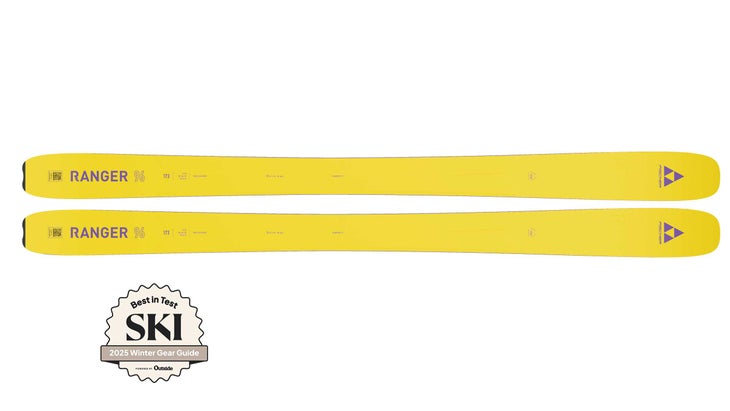
1. Best in Test
Fischer Ranger 96
Score: 7.99/10
Dimensions: 128-96-119 mm
Lengths: 159, 166, 173, 180, 187 cm
Turn Radius: 16 m (166 cm)
Weight: 1,775 g (166 cm)
Pros and Cons
⊕ Most versatile ski in the test
⊕ Extremely energetic
⊗ Not wide enough for deep powder
⊗ Rough ride in crud
Though technically a unisex ski that comes in women’s-appropriate lengths, the Ranger 96 was our ladies’ favorite all-mountain offering at this year’s SKI Test.
Topping the charts in the versatility scoring department—the holy grail for this all-condition, all-terrain category—this ski proved itself in nearly every medium, ripping on groomers, bombing through crud, and sucking up bumps. The only condition that testers didn’t think the Ranger 96 would be suited for is deep powder, where its 96-millimeter waist width and relatively narrow tip might sink. Testers called the Ranger 96 one of the most versatile options in terms of ability level, too, as suitable for someone just learning the art of the carve as it is for experts who charge.
The word testers repeated in their feedback of this ski was “energetic,” a trait reflected in its category-topping score in playfulness. “I loved its poppy nature,” commented Courtney Harkins, the director of marketing for the U.S. Ski and Snowboard Association. That energy and rebound—thanks to a full wood core and sandwich sidewall construction—makes for seamless transitions between short and long turns, bumps and trees, or groomers and steeps.
As for quibbles, there were a few about tip chatter and feedback in crud and heavy snow, despite the layer of damping metal. But most felt it to be a solid, comfortable daily driver for those who want skiing to be more fun and less work.
Read our full review of the Fischer Ranger 96 here.
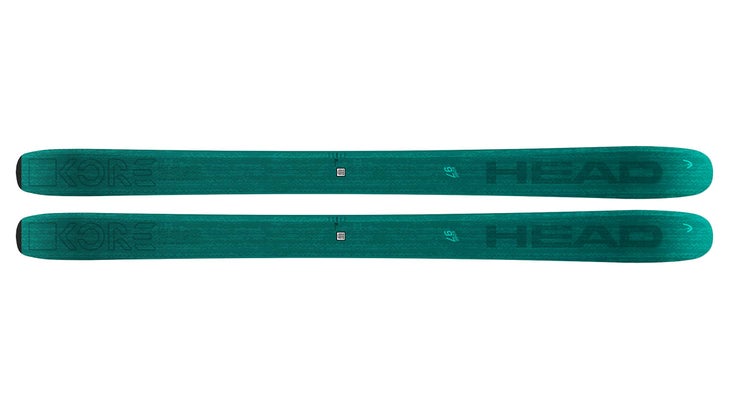
2. Most Forgiving
Head Kore 97 W
$700 at Amazon $700 at Ski Essentials
Score: 7.56/10
Dimensions: 131-97-118 mm
Lengths: 156, 163, 170, 177 cm
Turn Radius: 15.3 m (170 cm)
Weight: 1,640 g (170 cm)
Pros and Cons
⊕ Ideal for soft snow
⊕ Forgives imperfect technique
⊗ Too light to bite on ice
⊗ Chattery in crud
When testers picked the Head Kore 97 W off the rack, they found it so light they worried it wouldn’t have the chops to hold up in changing spring conditions, which varied from punchy windboard to avalanche debris. They were pleasantly surprised to find a capable all-rounder suitable for most skiers most of the time.
“Whatever the weather may bring, the Head Kore will make skiing feel easy,” said Erika Northrop, a 41-year-old expert who lives in Taos, New Mexico.
The ski’s lightweight wood core gets structural stability from carbon layers and a sandwich cap construction, and a lack of metal keeps it light and responsive. As a result, testers found it easygoing, forgiving, and balanced—especially in soft snow—awarding it top scores for flotation and forgiveness. It’s also friendly enough for intermediates and strong enough for experts who keep to moderate speeds.
As in many things, however, its strength is also its weakness: It’s too user-friendly to bite into firm snow. Its metal-free constrution also means it can get tossed around in set-up snow and chattery in chunder. But then again, who wants to ski chunder?
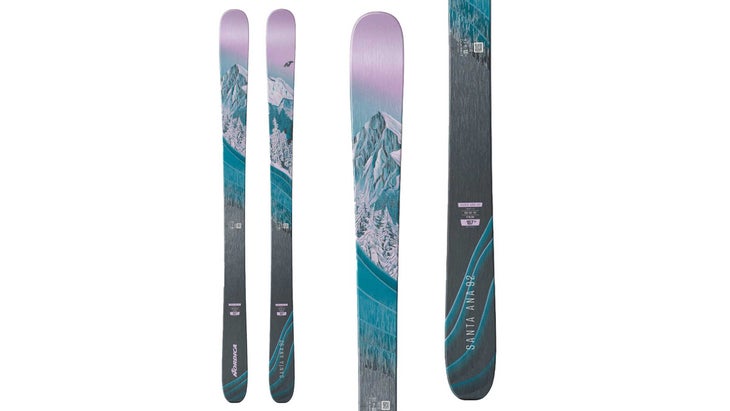
3. Best for Experts
Nordica Santa Ana 92
Score: 7.36/10
Dimensions: 123-92-111 mm
Lengths: 150, 155, 161, 167, 173, 179 cm
Turn Radius: 17 m (167 cm)
Weight: 1,840 g (167 cm)
Pros and Cons
⊕ Quick, especially in shorter lengths
⊕ Stable in all conditions
⊕ Good value
⊗ Not wide enough for deep days
⊗ Longer lengths lack energy
The new Santa Ana 92 is part of the largest ski project Nordica has ever embarked on, building new molds for all four Santa Ana models and for all four in her brother line, the Enforcer. Two years of R&D later, testers are thrilled with the changes.
With a new metal laminate that is tailored to each ski’s waist-width, the Santa Ana 92 gets a solid albeit lighter dose of metal, which accounts for its dependable edge-hold on hardpack and determination in crud. A new profile that adds more rocker to the tail also makes the ski easier to maneuver and more agile.
But testers agreed that, like the previous version, it’s still best for experts who aren’t afraid to mash on the gas. “It’s a consistent ski that will do anything you ask—but you do have to ask it,” summed up tester and collegiate ski racer Courtney Harkins.
A few others noted it was quicker in shorter lengths and griped that it loses some rebound in the longer options. Some also felt it’s best suited for what resort marketers call “packed powder” days (i.e. low tide), owing to being on the narrow side of the category. But the overriding consensus: For women who rip, it’s either an ideal Eastern one-ski quiver, or a versatile Western all-mountain tool for all days but the deep ones.
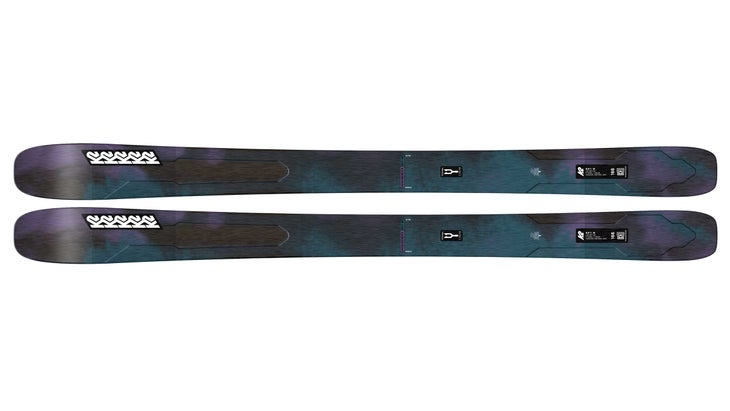
4. Best for Soft Snow
K2 Mindbender 99Ti W
Score: 7.18/10
Dimensions: 134-99-120 mm
Lengths: 154, 160, 166, 172, 178 cm
Turn Radius: 15.4 m (166 cm)
Weight: 1,887 g (166 cm)
Pros and Cons
⊕ Playful and fun
⊕ Most at home in soft bumps
⊗ Not enough bite for East Coast ice
⊗ Prefers to make one turn shape
The Mindbender 99Ti W is the harder charging cousin of the Mindbender 99C W, thanks to a layer of Titanal (hence the Ti). K2 strategically places said metal under the edges in the tip, full width underfoot, and tapered in the tail—giving the ski more hard-snow bite without adding too much weight.
Most testers felt it added just the right amount of strength to an otherwise easygoing and forgiving ride. It’s a directional ski to be sure, but not so much that it yanks you by your collar when you set it on edge. In fact, some felt it wasn’t quite enough bite to hold on East Coast ice, but for soft snow conditions, it’s game for anything that comes its way—especially soft bumps and trees, which is its natural habitat.
A low, gradual rise in the tip helps the ski initiate turns easily and absorb bumps, but when you get it up to speed, it quiets down just fine. Most testers felt it had a big sweet spot for intermediate skiers on up.
“One of my favorites in the test for how fun, forgiving, and accessible it was,” said Outside associate gear director Jenny Wiegand. “Makes skiing less-than-ideal conditions fun.”
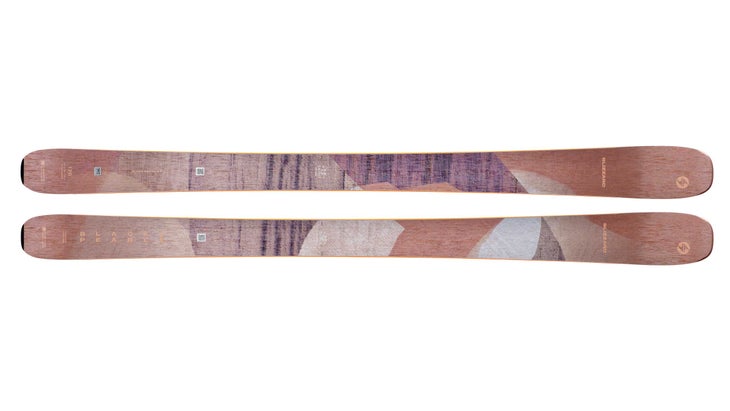
5. Best for Hard Snow
Blizzard Black Pearl 94
Score: 7.16/10
Dimensions: 131.5-94-13.5 mm
Lengths: 152, 158, 164, 170, 176 cm
Turn Radius: 14.5 m (164 cm)
Weight: 1,750 g (164 cm)
Pros and Cons
⊕ Powerful and stable
⊕ Precise on hardpack
⊕ Strong carver
⊗ Prefers harder snow
⊗ Not the most forgiving
Ladies, meet your new set of knives. Earning top marks in the category for hard-snow integrity, stability at speed, and carving, the Black Pearl 94 knows a thing or two about arcing.
Completely redesigned this year, the new Black Pearl line boasts some learnings from its sister Sheeva line, with a new metal laminate to add stability, grip, and precision, and a more generous rocker profile to make turn initiation and exit easier. The waist-width also shrinks from 97 millimeters to 94, following the all-mountain narrowing trend that allows this ski to rip groomers.
Testers felt the difference—and most of them were all for it. “It has the same power, but it’s more approachable and has a better waist-width,” said Vail-based tester Lauren Engle, managing partner of Outdoor Divas.
Most deemed it suitable for intermediates on up, with a low barrier to entry, yet noted that it’s not the most forgiving in the category. Others thought it lacked liveliness and playfulness. But all agreed it was most at home on-piste (an opinion that may have been influenced by a sharp edge tune at the Mt. Rose test that made it feel a little hooky and could have impacted its mediocre forgiveness score).
It is, by all accounts, a sturdy platform for experts who can truly appreciate its gifts.
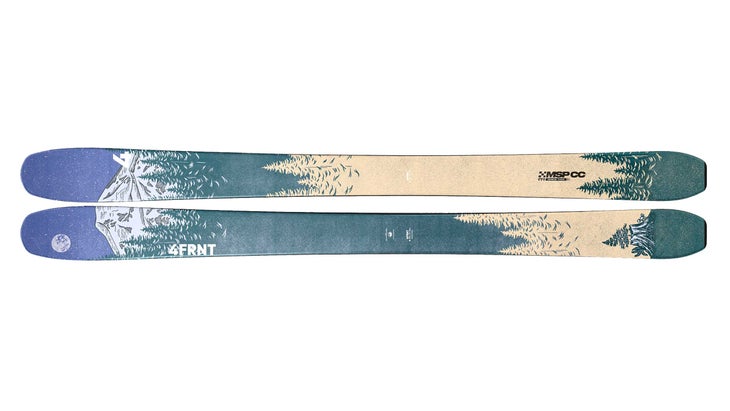
6. 4FRNT MSP CC
Score: 7.13/10
Dimensions: 132-99-121 mm
Lengths: 159, 165, 171 cm
Turn Radius: 15.7 m (165 cm)
Weight: 1,888 g (165 cm)
Pros and Cons
⊕ Exceptional crud performance
⊕ Has some serious backbone
⊗ May be too stiff for intermediates
⊗ Not very forgiving of mistakes
Not many ladies had heard of this indie ski five years ago, but now it returns to our list of the best women’s all-mountain skis for the fourth consecutive year. It’s hard to beat the MSP CC’s confidence-inspiring performance off the groomers, our testers say, especially in trickier conditions and terrain.
“This ski makes quick work of crud,” noted Colorado-based tester Lauren Engle. “It’s responsive enough to take some of the leg burn out of a long bump run, and yet still gives a decent ride on a groomer.”
The MSP CC’s chops in crud aren’t surprising given its 99-millimeter waist and solid aspen-maple core reinforced with a Titanal laminate, which together make it wide enough and stiff enough to plow through chopped-up snow. Some testers noted that it’s a little too wide to hang in a true carved turn on-piste, but others were quick to forgive that shortcoming in light of its versatility and off-piste prowess.
It is on the stiffer, damper end of the spectrum, and testers recommend sizing down if you want to tap into this ski’s more playful, energetic side—even if you’re a strong expert. The MSP CC also doesn’t forgive sloppy skiing habits easily, especially in the longer 171-centimeter length.
“It’s a great all-mountain option for strong skiers with a traditional stance,” summed up Outside Associate Gear Director Jenny Wiegand. “Drive it, and it will do your bidding, no questions asked, regardless of the conditions.”
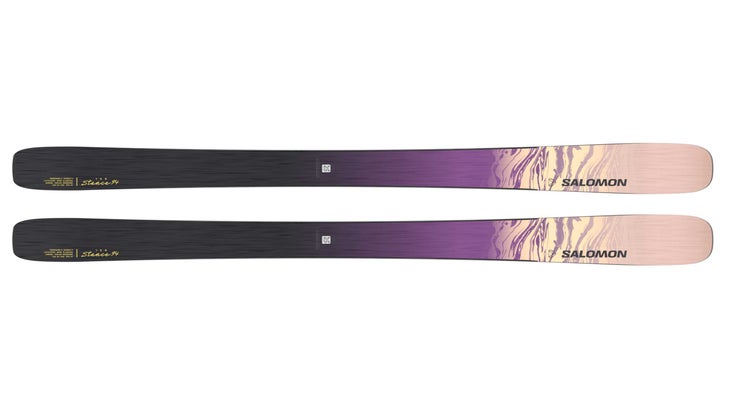
7. Salomon Stance W 94
Score: 7.04/10
Dimensions: 124-94-106 mm
Lengths: 154, 161, 168, 174 cm
Turn Radius: 18 m (161 cm)
Weight: 1,690 g (161 cm)
Pros and Cons
⊕ User-friendly
⊕ Easygoing
⊗ Chattery at high speed
⊗ Balks at crud
If the Salomon Stance W 94 has an, um, stance, it’s that skiing isn’t meant to be taken too seriously. An energetic ride that is happy to go wherever you please, it’s an easygoing multitool for women who just want to have fun.
Unchanged for this season, it’s made with a wood core sandwiched between two sheets of vibration-damping metal, yet it still manages to feel lightweight and lively—ideal, most testers thought, for intermediate to advanced skiers. High experts, they felt, may be underwhelmed with its ability at high speeds, where it starts to chatter. Its biggest weakness: when conditions get tough, the fun-loving Stance W 94 just wants to get back to the party. (It tied for last among skis on this list in crud performance.)
The Stance thrives in soft snow, turning up its nose a bit at true hardpack, where precision is required. However, the majority of testers felt it could do whatever is asked of it in most conditions and terrain. It has the longest turn radius among this year’s winners, which, on paper, means it should feel most at home making longer turns. But testers found the Stance W 94 was just as happy—if not happier—firing off short-swing turns and zipping through bumps and tight terrain.
“It’s not for big-mountain lines or huge powder days, but for the vast majority of days in the mountain West, it’s awesome,” said Outside gear editor Kelly Klein, who calls Montana’s Bridger Bowl her home hill.
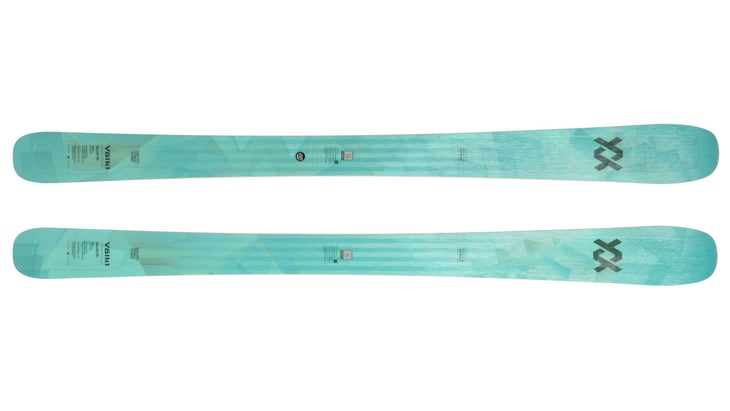
8. Völkl Secret 96
Score: 6.75/10
Dimensions: 139-96-121
Lengths: 149, 156, 163, 170, 177
Turn Radius: 15.2 m (170 cm)
Weight: 1,910 g (170 cm)
Pros and Cons
⊕ Precise edge performance
⊕ Exceptionally stable at speed
⊕ Dependable on firm snow
⊗ Not suited for deep powder
⊗ Geared toward experts
While nearly all testers agreed that the newly redesigned Völkl Secret 96 was even more demanding and precise than the previous iteration, they couldn’t quite agree on whether or not that was a good thing.
“Step on the gas and enjoy the ride,” said Taos, New Mexico-based tester Erika Northrop.
“If you aren’t skiing with speed, this ski isn’t talking to you,” said tester Lauren Engle, a 5’4” tester from Vail, Colorado.
The new Secret 96 features the same metal laminate underfoot for edge-grip and a redesigned Tailored Carbon Tip for consistent feel and reliable turn initiation, but it boasts wider tips and tails and yet another turn radius to the three Völkl built in previously.
The idea is to make the tips and tails have a more open radius to cruise longer turns, with a tight radius underfoot to snap off tight corkscrews. Testers gave it high marks for both, so the tech seems to work on hardpack, though it wasn’t the most versatile off-piste (it scored the lowest marks in the category for flotation).
The Secret 96 also scored dead-last among the skis on this list in forgiveness. However, most testers agreed that for those who are willing to work for it, this ski will reward with precision, responsiveness, and glorious G-forces at eye-watering speed.

9. Rossignol Super Black Ops 98
Score: 6.74
Dimensions: 131-98-121 mm
Lengths: 162, 172, 182, 192 cm
Turn Radius: 14 m 162 cm
Weight: 1,800 g (162 cm)
Pros and Cons
⊕ Dependable at speed
⊕ Capable in a wide range of terrain
⊗ Lacks energy
⊗ Size run doesn’t include shorter sizes
First, we love this ski’s badass name and history: the Black Ops line spent years as athlete-only skis, shrouded in secrecy and pressed in limited quantities. But when it comes to the Super Black Ops 98, well, its rad 90s graphics may be truer to its character.
Putting up solid scores across the board, this is a very versatile all-rounder that welcomes a variety of skill levels in a variety of terrain. Though it may be the master of none, it’s capable of all, which is what the all-mountain category is all about. “I love this ski,” said one New Mexico-based tester. “It’s very approachable but still asked something of me.”
Forgiving in bumps, surfy in powder, carve-y on groomers, it’s a solid platform for anyone who’s starting to explore the mountain, as well as experts who know it like the back of their hand. A wood core makes it lively, and a vibration-damping rubber layer in the tip keeps it steady, especially at high speeds.
Some testers felt it lacked energy, playfulness, and personality, calling it “a little boring.” Others worried about the sizing—being a unisex ski, it only goes down to 162 centimeters and then goes up in 10-centimeter increments from there. “The 162 skis pretty short, but 172 is a big jump,” said one 5-foot-4 tester.
Overall, those who want to buy these skis for the graphics alone will not be disappointed in their performance: The Super Black Ops 98 is a dependable charger.
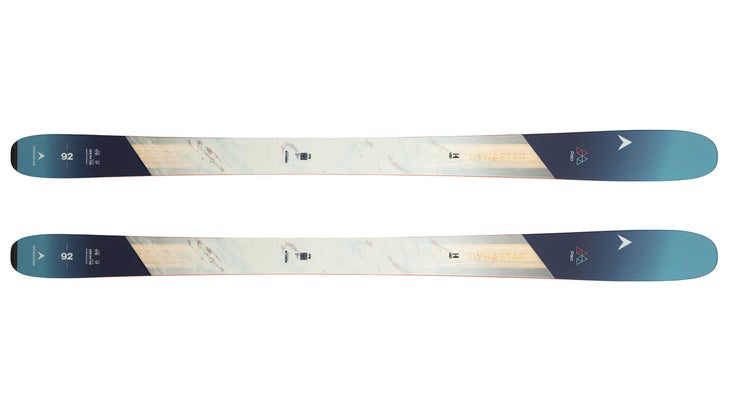
10. Dynastar M Pro W 92
$700 at Backcountry $700 at Dynastar
Score: 6.74/10
Dimensions: 126-92-116 mm (162 cm)
Lengths: 146, 154, 162, 170, 178 cm
Turn Radius: 15 m (162 cm)
Weight: 1,600 g (162 cm)
Pros and Cons
⊕ Confidence-boosting
⊕ Trustworthy
⊕ Good tool for tackling steeps and bumps
⊗ Lacks liveliness
⊗ Not for lesser experts
The Dynastar M Pro W 92 is a new iteration of the M Pro W 90, with a tighter turn radius (hello, steep chutes), lighter weight, slightly wider waist, and a new, eco-friendlier core. It also has more rocker in the tail to release turns easier and give it a looser feel.
By and large, testers agreed the proud French brand made an improvement, and noted that while it prefers soft snow to boilerplate (who doesn’t?), it performed well in all terrain at Mt. Rose—soft bumps, tight trees, and open groomers alike. They also agreed it offers a dependable platform that will boost confidence for intermediates on up.
But when it came to the nuances of its personality, most testers felt it lacked energy and liveliness: “It doesn’t have the playful pop,” said SKI’s East Coast digital editor Jamie Aranoff. But the tradeoff is a very steady and solid ride that will boost skiers’ confidence all over the mountain. “It did it all, and it did it well,” said Park City-based tester Courtney Harkins.
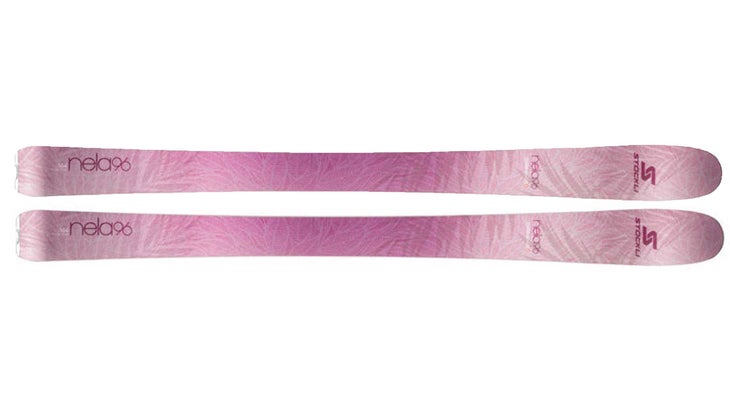
11. Stöckli Nela 96
$1,249 at Evo $1,249 at Ski Essentials
Score: 6.64/10
Dimensions: 134-96-121
Lengths: 156, 164, 172
Turn Radius: 15.8 m (164 cm)
Weight: 1,630 g (164 cm)
Pros and Cons
⊕ Stable at speed
⊕ Smooth
⊕ Takes skiing seriously
⊗ Dives in powder
⊗ Takes skiing seriously
Some ski brands have an unmistakable feeling to them, regardless of what model you’re on. Stöckli is such a brand. Handmade in Switzerland with the precision and meticulousness of well, all things made in Switzerland, these skis have a smoothness that makes any condition—even frozen ocean—feel like a glassy tube on a surfboard.
Redesigned this year with a thinner sheet of fiberglass under the wood core, the Nela 96 is built to be lighter and more agile than versions past, but testers didn’t feel much of a change, noting a stuck-to-the-snow heft that can make the ski feel so damp that it lacks energy. The Nela 96 prefers longer turns and busting crud over surfing in pow, earning one of the lowest scores among skis on this list in flotation.
But testers agreed that its stability lends itself to a wide range of ability levels, noting that it will hold the hand of lesser experts and show them the art of the carve. But if you get it up to speed and know how to find your edges, that’s when its true nature shines. “This one makes you feel like a World Cup racer on groomers,” said Outside associate gear director Jenny Wiegand.
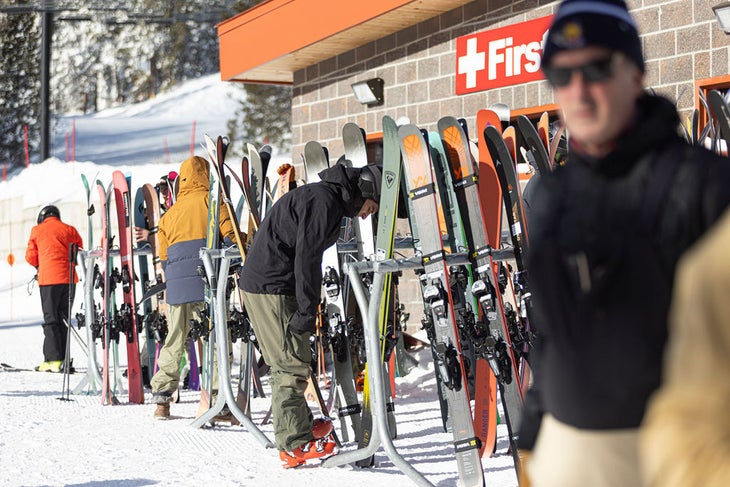
About the SKI Test
- Number of skis tested: 15
- Number of testers: 13
- Testing location: Mt Rose, Nevada
- Average age of tester: 37
- Average height of tester: 5’5”
SKI has been running its annual SKI Test for decades now, but we’re always tweaking and perfecting the process. Last March, we invited a crew of seasoned industry professionals—ski instructors, ski shop employees, coaches, and former World Cup racers—to join us for a week-long gear test at Mt. Rose, Nevada, a lesser-known indie resort with amazing terrain, including its notorious Chutes.
The mission: Jump on every pair of skis entered, put them through their paces all over the mountain, and then fill out a digital scorecard with comments and impressions of how each pair of planks performed across nine skill categories—from carving chops and crud performance to stability at speed and responsiveness.
Learn More: Understanding SKI Test Scoring Criteria
We asked our crew of 27 testers across different ski categories to identify each ski’s primary strengths, weaknesses, who it’s designed for, and what terrain and snow conditions it’s most adept at. At the end of the week, we had enough hard data on the 100-plus pairs of skis tested to make your head spin, and we use it all to bring you these reviews of the best skis of the year.
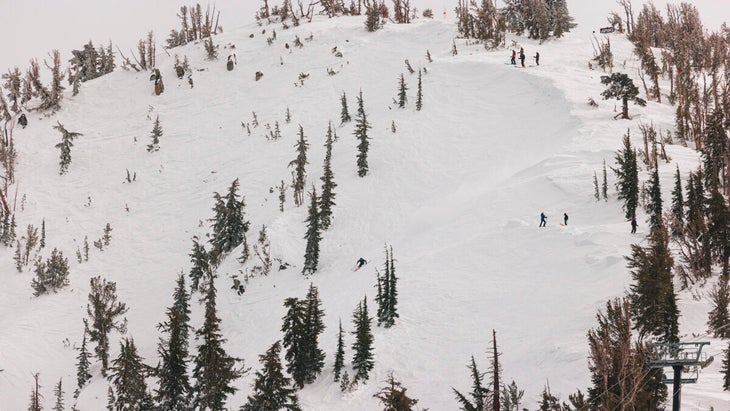
When judging all-mountain skis, we primarily assess how versatile it is in terms of the type of terrain and snow conditions it can handle. So at Mt. Rose, we put the all-mountain skis through the wringer, testing them on groomers, in the bumps, in glades, and in Mt. Rose’s Chutes, where powder stashes can be found days after the last storm.
Lucky for us, we didn’t have to make do with stale powder—we hit Mt. Rose right after the bomb cyclone that shut down Tahoe-area resorts for four days to give mountain ops teams enough time to clear the feet of snow that dropped on resorts in the area.
The skis that impressed us the most with their balance of skills on hard snow and in powder, in tight terrain and on wide open groomers, made this list of the best all-mountain skis of the year.
Testing Women’s Skis vs. Unisex Skis
The idea of women’s-specific skis is a contentious one. Some brands don’t make anything but unisex skis because they argue that gender doesn’t factor into how a ski performs—only weight, height, strength, and skier ability count. They therefore only produce unisex skis, but make them in shorter lengths (sometimes down to 162 centimeters or even 158 centimeters) to be more inclusive towards women.
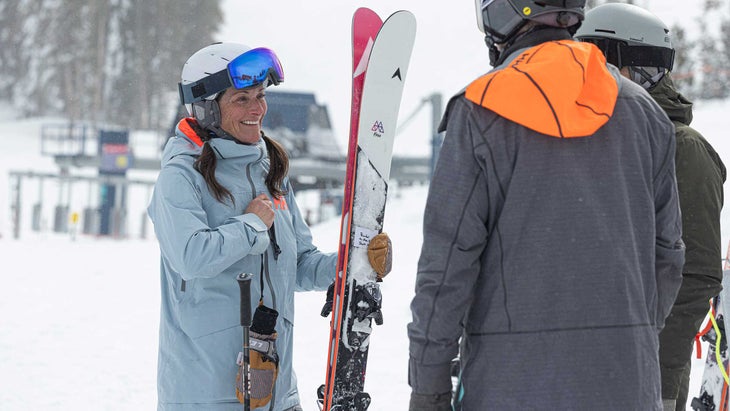
Other brands have invested a lot of time and money into developing true women’s-specific skis—skis that feature construction modifications from their unisex counterparts to account for a woman’s physique and body mechanics. The third approach: some brands only appear to offer women’s-specific skis, but those skis are often exactly the same as their unisex counterparts and just feature a different top sheet and women’s-specific model name.
This makes the whole idea of testing “women’s” skis a little complicated. Because many of the skis we’ve covered on our “best women’s skis of the year” lists in the past are, in fact, unisex skis that female testers loved, we’ve moved to testing unisex skis in the women’s category provided the ski comes in an approachable length for women (in the 162-centimeter range or below).
This means that some of the skis on this list are unisex skis that our lady testers loved and would not hesitate to recommend to other ladies. If you, like many of our female testers, prefer a longer ski that has some heft to it, don’t be scared off by the “unisex” designation. Rest assured that all the skis on this year’s list (whether unisex or women’s-specific) are tested by women and recommended for women.
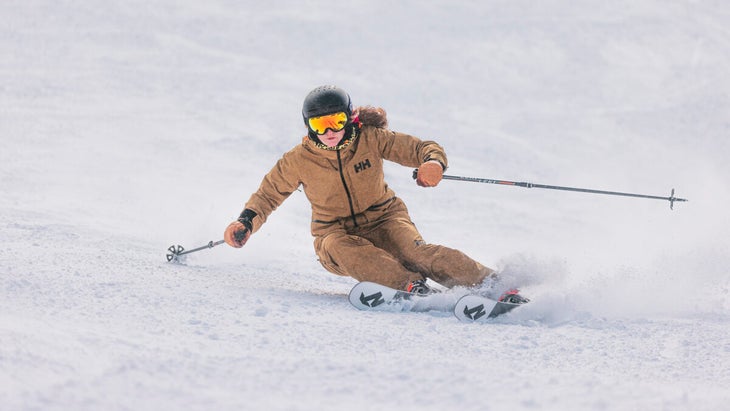
Meet Some of Our Testers
Below are a few of our many ski testers this year.
Kimberly Beekman
Age: 48 | Height: 5′4″ | Weight: 112 lbs
Kimberly Beekman has been testing skis and writing gear reviews for longer than she’d like to admit. She’s a former editor of SKI and freelance contributor to both SKI and Outside. She lives in Steamboat Springs with her wonderful daughter and terrible cat.
Avery Pesce
Age: 41 | Height: 5′6″ | Weight: 138 lbs
Originally from the North East, Pesce now lives in Midway, Utah, but still calls the ski areas of Vermont and New Hampshire home. She’s an expert skier with an aggressive style that she applies to any and all types of terrain and snow conditions. As the head ski buyer for Boston Ski & Tennis in Newton, Mass., she knows a thing or two about skis—how they’re built, how they perform, and who they’re best suited to.
Courtney Harkins
Age: 34 | Height: 5′8″ | Weight: 135 lbs
Courtney Harkins grew up ski racing, starting on the icy slopes of New England and finishing at the University of Colorado at Boulder. She now lives in Park City, Utah and works as the director of marketing and communications for the U.S. Ski & Snowboard Team. When she’s not traveling with the team, her home mountain is Deer Valley Resort, where she loves to arc turns on groomers, but also knows all the secret spots for days-old powder.
Frequently Asked Questions
What Is An All-Mountain Ski?
From groomed runs to moguls to the steep-and-deep freeride terrain, all-mountain skis are designed to take on the entire mountain. They usually feature a waist from 85 to 100 millimeters, tip rocker, and some tail rocker.
The majority of all-mountain skis that our testers prefer feature wood cores and some metal—but there are exceptions that include no metal at all in favor of keeping the ski light and more playful.
It’s hard to beat the versatility of an all-mountain ski, though these skis can be too wide for those who spend the majority of their time on groomers, and too narrow for those who ski mountains blessed with regular and bountiful snowfall.
Read more: Can wider skis hack it back East?
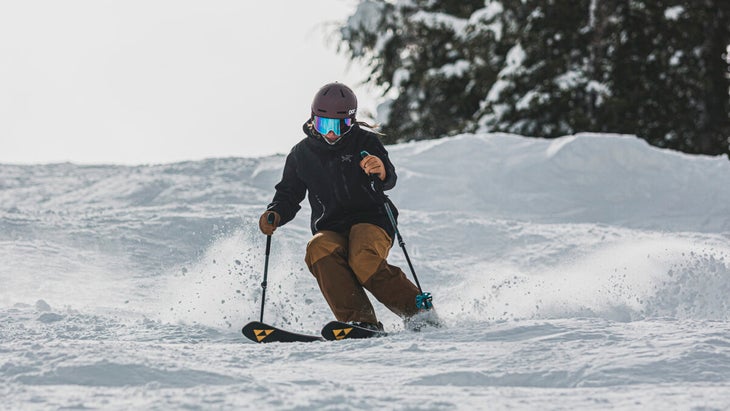
What’s the Difference Between the All-Mountain and Frontside Ski Category?
The line can be blurry between these two ski categories since ski manufacturers started throwing everything they have at producing well-rounded and versatile skis in both. As a result, you can now find narrow all-mountain skis that also rail on groomers and frontside skis that can hold their own in crud.
That said, there are still some key differences between frontside and all-mountain skis, the biggest being that frontside skis are primarily designed for on-trail performance, while all-mountain skis (even the narrower ones) are engineered to tackle conditions and terrain off the groomers. Learn more here.
How Long Do Skis Last?
With proper care and regularly performed tuning by a professional ski tech, skis can last for 200-300 days on snow depending on the size and aggressiveness of the skier. Larger skiers and people who are harder on their equipment will not get as many days on snow before the wood core, edges, or other aspects of the ski become compromised. Bindings should be tested by a professional ski tech every season, and replaced when they do not meet standardized norms.
What Length Ski Is Right for Me?
As a general rule of thumb, the shorter the ski, the easier it is to turn and control. So if you’re a beginner, reach for a ski that’s about chin-height. More advanced skiers often choose skis that are as long as they are tall, since longer skis provide more stability at speed and float in deep snow. So the best ski length for you will depend on your height, your skill level, and what type of skiing you hope to do. A ski-shop employee can help point you in the right direction.
Note that ski length is relative. Narrow carving skis tend to ski longer than their length because they feature more effective edge, while powder skis tend to ski shorter than their length because they feature more rocker in the tip and tail. Learn more here.
